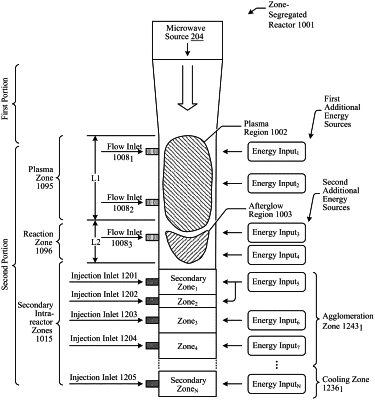| CPC H01J 37/32192 (2013.01) [H01J 37/32229 (2013.01); H01J 37/3244 (2013.01); H01J 37/32532 (2013.01); H01J 2237/334 (2013.01)] | 17 Claims |

|
1. A reactor system comprising:
a microwave source configured to generate a microwave energy;
one or more independently controllable heating sources;
a field-enhancing waveguide (FEWG) disposed downstream the microwave source, extending in-line with it and including a plasma zone and an afterglow region and characterized by a cross-sectional area that decreases along a portion of a length of the FEWG, the FEWG comprising:
a supply gas inlet disposed downstream of the microwave source, and configured to provide a supply gas to the FEWG, wherein a majority of the supply gas is configured to flow in the direction of microwave propagation along the length of the FEWG;
the plasma zone disposed in fluid communication with the supply gas inlet and configured to generate a plasma in response to excitation of the supply gas by the microwave energy wherein the microwave source or the FEWG is configured to direct microwave energy directly into the plasma zone and not through a dielectric window or wall;
a process inlet configured to inject a raw material into one of the plasma zone or the afterglow region disposed downstream of the plasma zone wherein the afterglow region is disposed in thermal communication with the one or more independently controllable heating sources and configured to produce a plurality of carbon-inclusive particles by reacting the plasma and the raw material; and
an outlet disposed downstream of the afterglow region and configured to output the plurality of carbon-inclusive particles.
|